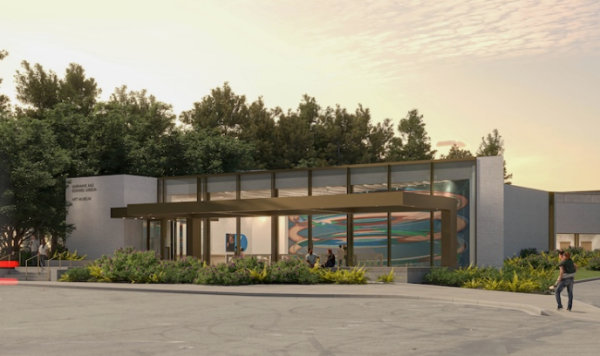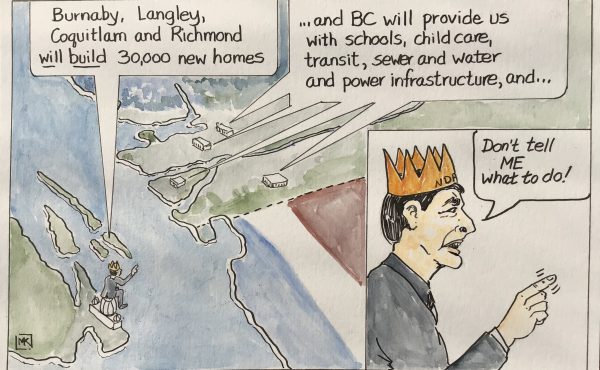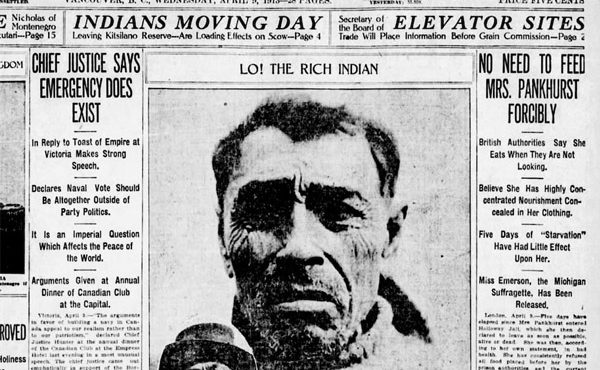
Located at the east end of the SFU mountaintop campus and sitting beside a mature stand of trees lining its central promenade, visitors can appreciate how the new Marianne and Edward Gibson Art Museum sits so unassumingly in its surroundings. It’s as though it had been there all this time, and has only recently been unearthed by the joint venture of Hariri Pontarini and Iredale Architecture.
Out of respect for the original vision of the 1963 campus masterplan as conceived by Arthur Erickson and Geoffrey Massey, the long, low building treads lightly on the earth, sitting alongside the great ceremonial walkway that runs from one end of the campus to the other, through the campus quad to the great convocation hall and beyond.
And with much having been said already about this new art museum at SFU—including pieces in CTV news, Vancouver Magazine and the Tyee—praise must go to gallery director Kimberly Phillips and the art museum team for their amazing job getting the word out about this new purpose-built gallery. With its official opening having taken place at the end of September to much fanfare, the gallery is currently open daily, Wednesday to Sunday, free of charge, and sits directly next to the SFU bus loop, which will soon be steps away from the terminus of a new planned SFU gondola!
As recipient of a 2023 Canadian Architect Award of Merit, the design parti quite literally has broken out of its box, with its five galleries radiating outward around an open, gathering place/hearth at the building’s centre. Using a consistent 15′ ceiling height throughout the building, the bleached glulam joists of the ceiling, along with the light hardwood flooring running throughout, connect all the galleries, while the wood grain of both the ceiling structure and hardwood provides directionality, orienting the visitor. Built on a budget of $26 million, the 12,000 sq.ft. art museum occupies what was a surface parking lot on the east end of the campus. It is now a state-of-the-art building, providing Class A gallery spaces and targeting LEED Gold with a net zero emission, electrified plant.
With several mid-rise towers continuing to be built out on the eastern periphery of the campus, a small commercial village has now been developed on the south edge of the bus loop—including the requisite student pub and coffee shop—with the new art museum arriving as an exclamation point at this end of campus and acting as an anchor for the cultural precinct taking bloom.
Anchored to the site by vertical buttresses of light coloured brick—which, along with the wood interiors, emerges as the main material expression of the building, both inside and out—the building’s mass is periodically broken up by tall expanses of glazing. As a further material counterpoint, the building’s two entry canopies are rendered in Corten steel, expressed as long Mies-like horizontal elements, with the one on the west facade gesturally reaching across a small courtyard to the béton brut of its closest original SFU neighbour, Strand Hall.
The building is named after Edward and Marianne Gibson. Marianne, who is a retired educator and art collector, was most instrumental in realizing the new building, according to Kimberly. Her late husband Edward, who taught geography at SFU, was also director of the SFU gallery from 1986 to 1997. Since that time, both of them have had this vision for SFU, of a place for showcasing art and educating the students, along with creating a place for them to linger with friends.
With the mountaintop campus literally on top of the world, Kimberly Philips believes the theme of the gallery’s inaugural exhibit –Edge Effects – is apt, given that the gallery is at the crossroads between the academic and residential buildings at SFU. It is exactly the sort of exhibition Edward would’ve wanted to see there.
Consolidating what were originally three smaller SFU galleries—one on Burnaby Mountain, the others downtown at the Woodwards and Harbour Centre campuses—the new single, larger gallery will also provide on-site storage for the 5,900 pieces in the gallery’s current collection. With plans to show 2-3 exhibitions a year, the next one is scheduled to open in February. The current show, Edge Effects, features fifteen artists working in many different media:
“We believe that Dr. Edward Gibson was excited by edges. He was known to teach classes outdoors, and pressed his students to challenge existing systems. He called for an art museum on SFU’s Burnaby Mountain campus because he believed in art’s capacity to catalyze conversations across disciplines, generations, and cultures. We are humbled to carry this vision forward, infuse it with SFU’s strong practice of creative and cross-disciplinary experimentation, and our own gallery team’s commitment to inclusivity.”
The current exhibitions must simply be seen to be believed (or heard as there is also auditory art on ‘display’). They include the semi-permanent Arboreal Time by Cindy Mochizuki at the gallery’s central open space. As the literal hearth of the building, her installation is situated over an electric fireplace surrounded by cozy, inviting couches.
Let the social condensing begin!
This also applies to the eastern entry hall, which has been furnished with a long social table. The gallery is intended as much as a social gathering place as it is a place to educate about and display art. Given its location and the potential for this end of the campus to grow (again, gondola), this new gallery feels right at home and is well worth the journey up the mountaintop to see.
With the difficulty the Vancouver Art Gallery has recently had getting its new space built, it is refreshing to see the new Gibson appear on our Metro Vancouver cultural landscape in relatively short order, with the client and architects very much taking a ‘non-Bilbao’ stance to achieve it. But one would be mistaken to think the Gibson Art Museum is quantity over quality—this is very much a thoughtful, context-sensitive addition to the campus fabric, in addition to being a top-quality work of architecture. Well done to all, and looking forward to a repeat visit very soon!
***
For more information on the Gibson Art Museum, visit the gallery’s website.
**
Sean Ruthen is a Metro Vancouver-based architect.



